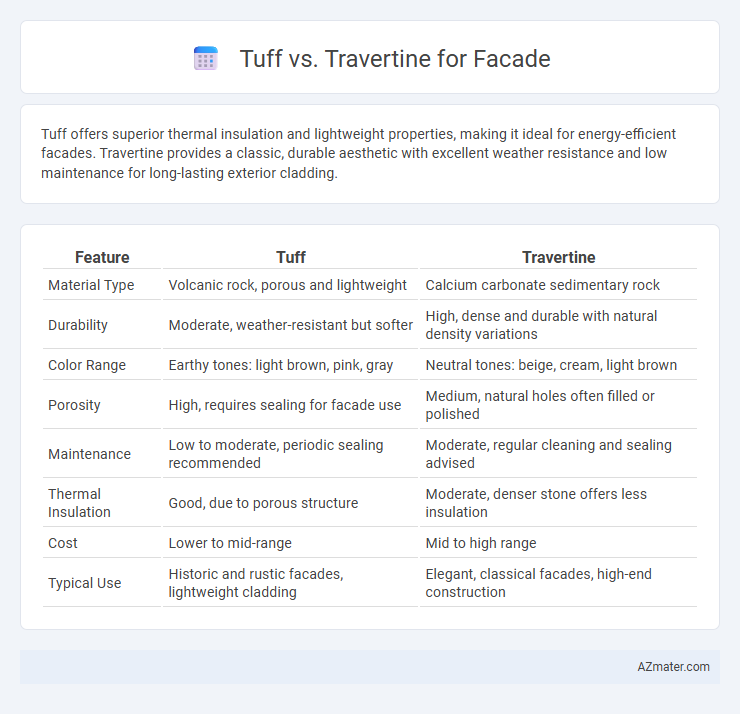Tuff offers superior thermal insulation and lightweight properties, making it ideal for energy-efficient facades. Travertine provides a classic, durable aesthetic with excellent weather resistance and low maintenance for long-lasting exterior cladding.
Table of Comparison
| Feature | Tuff | Travertine |
|---|---|---|
| Material Type | Volcanic rock, porous and lightweight | Calcium carbonate sedimentary rock |
| Durability | Moderate, weather-resistant but softer | High, dense and durable with natural density variations |
| Color Range | Earthy tones: light brown, pink, gray | Neutral tones: beige, cream, light brown |
| Porosity | High, requires sealing for facade use | Medium, natural holes often filled or polished |
| Maintenance | Low to moderate, periodic sealing recommended | Moderate, regular cleaning and sealing advised |
| Thermal Insulation | Good, due to porous structure | Moderate, denser stone offers less insulation |
| Cost | Lower to mid-range | Mid to high range |
| Typical Use | Historic and rustic facades, lightweight cladding | Elegant, classical facades, high-end construction |
Introduction: Tuff vs Travertine Facades
Tuff and travertine are both popular natural stones used for facades, known for their durability and aesthetic appeal. Tuff, a volcanic rock, offers unique porous textures and lightweight properties ideal for ventilation and thermal insulation. Travertine, a sedimentary limestone, features distinct veining and a smooth surface that enhances architectural elegance and weather resistance.
Geological Origins and Composition
Tuff, formed from consolidated volcanic ash, originates from pyroclastic materials ejected during explosive volcanic eruptions, resulting in a porous and lightweight stone rich in volcanic minerals like feldspar and quartz. Travertine, a sedimentary rock, develops through the precipitation of calcium carbonate from mineral-rich hot springs or limestone caves, characterized by its dense, banded texture primarily composed of calcite or aragonite. The distinct geological origins of tuff and travertine influence their mineral composition, durability, and aesthetic qualities, making tuff more porous and lightweight, while travertine exhibits greater density and intricate vein patterns suitable for elegant facade applications.
Visual Appeal and Aesthetic Differences
Travertine offers a timeless, classic aesthetic with natural veins and warm, earthy tones that create a luxurious and elegant facade. Tuff provides a more rugged, textured appearance with varied color palettes ranging from gray to rusty hues, lending a rustic and natural charm to building exteriors. The choice between tuff and travertine significantly impacts the facade's visual appeal, with travertine favored for refined sophistication and tuff preferred for organic, bold architectural statements.
Strength and Durability Comparison
Tuff offers moderate strength with good resistance to weathering but tends to be more porous and softer compared to travertine, making it less durable for high-impact conditions. Travertine boasts superior hardness and density, providing exceptional durability and resistance to abrasion, ideal for facades subjected to harsh environmental factors. The mineral composition of travertine enhances its compressive strength, typically ranging from 100 to 250 MPa, outperforming tuff's lower strength spectrum around 50 to 150 MPa.
Weather Resistance and Longevity
Tuff offers superior weather resistance due to its volcanic origin, making it highly durable against harsh climatic conditions and resistant to erosion, ideal for long-lasting facades. Travertine, formed from limestone deposits, provides excellent aesthetic appeal but is more porous and susceptible to weathering, requiring regular sealing to maintain longevity. For facade applications demanding minimal maintenance and maximum durability, tuff outperforms travertine in both weather resistance and lifespan.
Installation Process and Challenges
Tuff and travertine differ significantly in their installation process and challenges, with tuff requiring careful handling due to its porous and fragile nature, often necessitating specialized adhesives and support systems to prevent cracking. Travertine, being denser and more durable, allows for easier cutting and drilling but demands precise anchoring techniques to accommodate its natural veining and avoid surface damage. Both materials require skilled labor, but tuff's sensitivity to moisture and impact presents greater challenges in maintaining facade integrity over time.
Maintenance Requirements
Tuff requires minimal maintenance due to its natural durability and resistance to weathering, needing only occasional cleaning to prevent moss and dirt buildup. Travertine, being more porous, demands regular sealing to protect against moisture infiltration, stains, and erosion, making its upkeep more intensive. Proper maintenance of both stones ensures facade longevity, but tuff is generally favored for lower maintenance costs and efforts.
Cost Considerations
Tuff offers a more budget-friendly option for facades with lower quarrying and processing costs compared to travertine, which demands higher expenses due to its dense structure and intricate finishing. Maintenance costs for tuff are generally minimal because of its porous nature, whereas travertine can incur additional expenses over time due to sealing and upkeep requirements. Cost efficiency in facade projects often favors tuff when considering initial investment and long-term maintenance budgets.
Sustainability and Environmental Impact
Tuff stone offers superior sustainability due to its natural insulation properties, reducing energy consumption for buildings. Travertine, while durable, requires more intensive quarrying processes that result in higher environmental degradation and carbon emissions. Choosing Tuff for facades supports eco-friendly construction by minimizing resource extraction and enhancing energy efficiency.
Choosing the Right Stone for Your Facade
When choosing the right stone for your facade, tuff offers lightweight durability and excellent thermal insulation, making it ideal for energy-efficient buildings. Travertine provides a classic, elegant appearance with natural color variations and exceptional weather resistance, ensuring long-lasting beauty. Consider your climate, desired aesthetic, and maintenance preferences to select the optimal material for your facade project.

Infographic: Tuff vs Travertine for Facade
 azmater.com
azmater.com